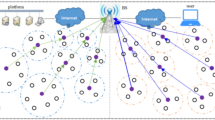Abstract
Clustering and multi-hop routing algorithms substantially prolong the lifetime of wireless sensor networks (WSNs). However, they also result in the energy hole and network partition problems. In order to balance the load between multiple cluster heads, save the energy consumption of the inter-cluster routing, in this paper, we propose an energy-efficient routing algorithm based on Unequal Clustering Theory and Connected Graph Theory for WSN. The new algorithm optimizes and innovates in two aspects: cluster head election and clusters routing. In cluster head election, we take into consideration the vote-based measure and the transmission power of sensor nodes when to sectionalize these nodes into different unequal clusters. Then we introduce the connected graph theory for inter-cluster data communication in clusters routing. Eventually, a connected graph is constituted by the based station and all cluster heads. Simulation results show that, this new algorithm balances the energy consumption among sensor nodes, relieves the influence of energy-hole problem, improve the link quality, achieves a substantial improvement on reliability and efficiency of data transmission, and significantly prolongs the network lifetime.







Similar content being viewed by others
References
Priyankara, Sampath; Kinoshita, Kazuhiko; Tode, Hideki; Murakami, Koso. (2011) A generalized spatial boundary analysis method for clustering/multi-hop hybrid routing in Wireless Sensor Networks. 2011 IEEE GLOBECOM Workshops, GC Wkshps 2011, Houston, TX, United states, 5–9 December, pp. 281–286. IEEE Computer Society, Washington
Thanigaivelu, K.; Murugan, K. (2012) Grid-based clustering with dual cluster heads to alleviate energy hole problem for non-uniform node distribution in wireless sensor networks. International Journal of Mobile Network Design and Innovation, 4(1), 3–13. Special Issue on Adaptation and Clustering in Mobile Networks.
Wu, Xiaobing; Chen, Guihai; Das, Sajal K. (2008) Avoiding energy holes in wireless sensor networks with nonuniform node distribution. IEEE Transactions on Parallel and Distributed Systems, 19(5), 710–720.
Olariu, Stephan; Stojmenovic, Ivan. (2006) Design guidelines for maximizing lifetime and avoiding energy holes in sensor networks with uniform distribution and uniform. Proceedings-INFOCOM 2006: 25th IEEE International Conference on Computer Communications, Barcelona, Spain, 23–29 April, pp. 1–12. Institute of Electrical and Electronics Engineers, New York City.
Li, Jian; Mohapatra, Prasant. (2007) Analytical modeling and mitigation techniques for the energy hole problems in sensor networks. Pervasive and Mobile Computing, 3(3), 233–254.
Chiang, Mu-Huan; Byrd, Gregory T. (2008) Neighborhood-aware density control in wireless sensor networks. Proceedings-IEEE International Conference on Sensor Networks, Ubiquitous, and Trustworthy Computing, pp. 122–129. Institute of Electrical and Electronics Engineers, New York City.
Song, Chao; Liu, Ming; Cao, Jiannong; Zheng, Yuan; Gong, Haigang; Chen, Guihai. (2009) Maximizing network lifetime based on transmission range adjustment in wireless sensor networks. Computer Communications, 32(11), 1316–1325.
Kumar, Vinay; Jain, Sanjeev; Tiwari, Sudarshan. (2011) Energy efficient clustering algorithms in wireless sensor networks: A survey. International Journal of Computer Science Issues, 8(5 5-2), 259–268.
Samira Kalantari, Mohsen Amiri besheli, Zeinab Sam Daliri, Shahaboddin Shamshirband and Liang Shing Ng. (2011) Routing in wireless sensor network based on soft computing technique. Scientific Research and Essays, 6(21), 4432–4441.
Heinzelman, W.; Chandrakaasan, A.; Balakrishnan, H. (2002) An Application Specific Protocol Architecture for Wireless Micro-sensor Networks. IEEE Transactions on Wireless Communications, 1(4), 660–670.
Younis, O.; Fahmy, S.. (2004) HEED: A Hybrid, Energy-Efficient Distributed Clustering Approach for Ad Hoc Sensor Networks. IEEE Transaction on mobile computing, 3(4), 366–379.
Shakkeera. (2010) Opath selection technique for flooding in link state routing protocol using forwarding mechanisms in MANET. Proceedings of 2010 International Conference on Communication and Computational Intelligence, INCOCCI-2010, pp. 318–323. IEEE Computer Society, Washington.
M. Chatterjee, S. Das and D. Turgut, WCA: A Weighted Clustering Algorithm for Mobile Ad hoc Networks, Journal of Cluster Computing, Special issue on Mobile Ad hoc Networking, Vol. 5, pp. 193–204, 2002.
Soro, Stanislava; Heinzelman, Wendi B. (2005) Prolonging the lifetime of wireless sensor networks via unequal clustering. Proceedings-19th IEEE International Parallel and Distributed Processing Symposium, IPDPS 2005. Institute of Electrical and Electronics Engineers, New York City.
Cheng-Fa Li, Gui-Hai Chen, Mao Ye and Jie Wu, An Uneven Cluster Based Routing Protocol for Wireless Sensor Networks, Chinese journal of computer, Vol. 30, No. 1, pp. 27–36, 2007.
Zhang, Ruihua; Ju, Lei; Jia, Zhiping; Li, Xin. (2012) Energy Efficient Routing Algorithm for WSNs via Unequal Clustering. Proceedings of the 14th IEEE International Conference on High Performance Computing and Communications, HPCC-2012—9th IEEE International Conference on Embedded Software and Systems, ICESS-2012, pp. 1226–1231. IEEE Computer Society, Washington.
Yeo, Myung Ho; Kim, Yu Mi; Yoo, Jae Soo. (2009) An energy-efficient distributed clustering approach in wireless sensor networks. IEICE Transactions on Communications, E92-B(2), 620–623.
OMNET ++. http://www.omnetpp.org/
Acknowledgments
We would like to thank anonymous referees for their helpful suggestions to improve this paper. This research is sponsored by the Natural Science Foundation of China (NSFC) under Grant Nos. 61402245, 61572267 and 61272425, the Project funded by China Postdoctoral Science Foundation under Grand Nos. 2015T80696 and 2014M551870, the Shandong Provincial Natural Science Foundation No. ZR2014FQ010, the Qingdao Postdoctoral Application Research Funded Project, the Open Project Foundation of Shandong Provincial Key Laboratory of Software Engineering under Grant No. 2013SE01, PAPD, CICAEET and Foundation of Huawei under Grant No. YB2013120027.
Author information
Authors and Affiliations
Corresponding author
Rights and permissions
About this article
Cite this article
Xia, H., Zhang, Rh., Yu, J. et al. Energy-Efficient Routing Algorithm Based on Unequal Clustering and Connected Graph in Wireless Sensor Networks. Int J Wireless Inf Networks 23, 141–150 (2016). https://doi.org/10.1007/s10776-016-0304-5
Received:
Accepted:
Published:
Issue Date:
DOI: https://doi.org/10.1007/s10776-016-0304-5




